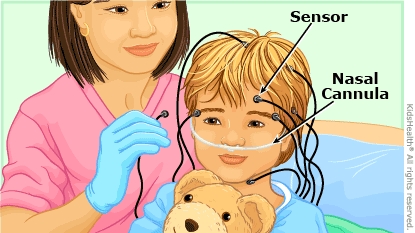Health care providers do a sleep study (also called a polysomnogram) to understand how a child is sleeping. Most sleep studies happen overnight in a private room that is dark and quiet. There is a bed for the child (or a crib for younger children) and also a bed or cot for a parent or guardian. A sleep technician is there to set up the equipment and answer questions.
Your child will wear sensors that are attached to wires on the head, nose, mouth, chest, belly, finger, and legs. The technician will attach them with stickers, tape, or paste. The sensors measure breathing, the amount of certain gases (oxygen and carbon dioxide) in the body, how the heart is beating, body movements, and brain waves. This information is sent to a computer. The sensors stay on until your child gets up in the morning, and come off easily after the study.
There is also a microphone to record sounds and a camera to record your child's sleep.
You and your child will go home early in the morning when the study is over.




Why is a sleep study done? Some sleep problems in kids that the study might show include: